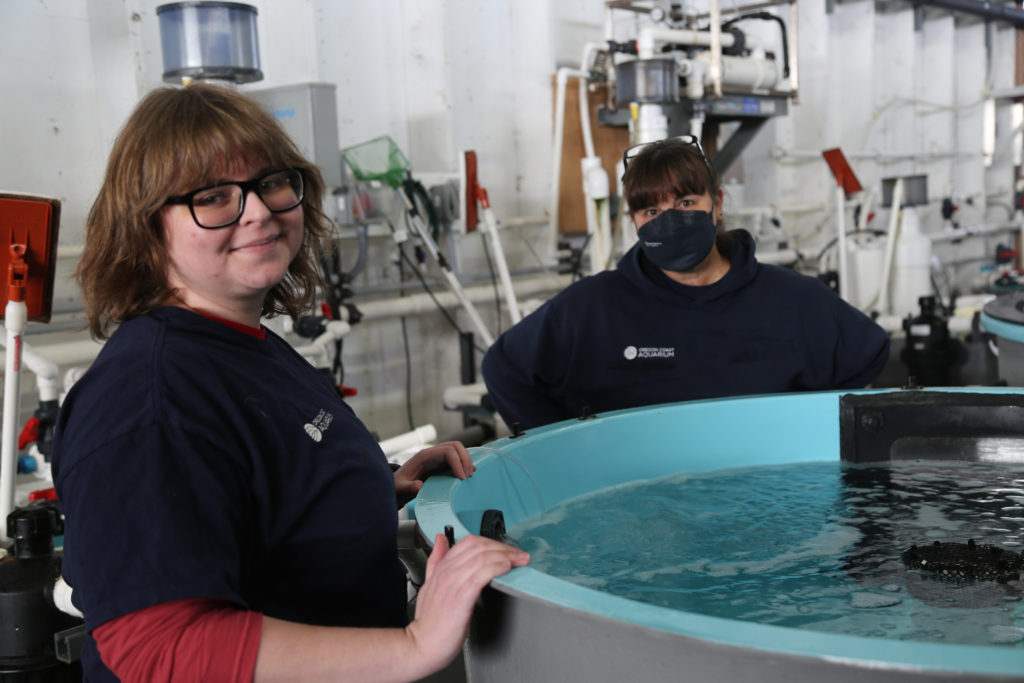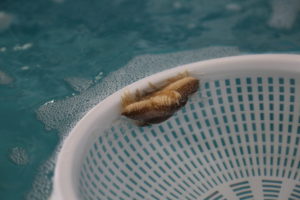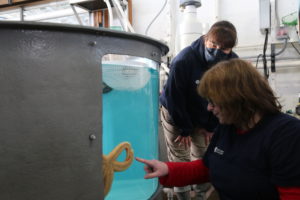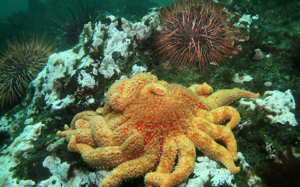
By DINO GRANDOI/The Washington Post
NEWPORT — In an old industrial warehouse, Tiffany Rudek leans into a chest-high tank. Using a laminated card, she gently pries a red-speckled sea star from the enclosure’s bright blue walls.
The starfish was reluctant, clinging with its tiny, tubular feet.
“It’s delicate to move them,” said Rudek, an aquarist at the Oregon Coast Aquarium. Reaching underwater, she unstuck it for its own good.
It was bath time for the sick sea star.

This leather star, like many starfish species, is supposed to have five arms. This one has four. A tuft of pale, spongy tissue is all that is left where its limb came off.
“Sometimes animals need a little help,” she said.
For the past decade, a mysterious illness has spread along the Pacific Coast, causing sea stars — more commonly known as starfish — to literally melt into goo. The outbreak has hit starfish from southern Alaska to Baja California in Mexico, decimating more than a dozen species. The ailment is so pervasive among the invertebrates in the region that even specimens in aquariums contract it. Some die within hours of showing symptoms.
No one is sure where the outbreak came from. And no one can agree on what exactly is causing it — whether the source is a virus, bacteria, a change in the environment or something else entirely.
But many biologists are sure of one thing: The disease, dubbed sea star wasting syndrome, threatens to drive some starfish to extinction and hints at deeper problems in Earth’s seas.
Unraveling treatment techniques
The disease isn’t just a disaster for sea stars. The crash of starfish populations is poised to make climate change even worse for other creatures on Earth by upending ecosystems that are home to hundreds of other species and crucial for keeping CO2 out of the atmosphere. Without starfish to prey on them, hungry sea urchins are devouring huge underwater kelp jungles that store carbon.
Scientists call it the largest known outbreak of any disease among marine animals to date, killing billions of individual sea stars. Now animal handlers at the Oregon Coast Aquarium have developed what they say is a novel treatment for the syndrome, in the hopes of someday rescuing and restoring starfish numbers.
Bending over, Rudek scooped the red-speckled leather star into a clear bucket and swirled an inky concoction meant to kill parasites that prey on its weakened flesh.
Resting on the bottom of the bucket, the star splayed its four remaining limbs against the container’s walls. The disinfected animal, Rudek said, was resting.
“It makes them feel better,” she said. “They’re like, ‘Oh, thank goodness, all of this ick on my body is now gone.’”
The first symptoms seem mild. A sea star may look a little flattened. Not as puffy as it once was. Then it will curl up, twisting one arm over another in a vain effort to protect itself from some phantom it cannot see.
As the wasting disease progresses, a sea star develops white, oozing lesions. Its arms detach from its body — and the zombie limbs walk away on their own to die. In the end, all that is left is a slimy pile of tiny bones and deteriorated flesh.
The outbreak was first identified in 2013 in Washington before scientists spotted melting stars up and down the coast. For a while, the epidemic appeared to spare Oregon. Then in early 2014, a visitor came into the Oregon Coast Aquarium in a panic.
“She said, ‘I need a marine biologist,’ ” recalled Evonne Mochon Collura, a sea jelly specialist and assistant curator of fish and invertebrates. The resident saw a tide pool with a galaxy of gooey stars.
Doug Batson, a diver with the aquarium in Newport, confirmed their worst fears after seeing something akin to a crime scene while diving in Yaquina Bay that spring.
“One arm totally in the middle of nowhere off by itself,” he said. “And another arm a few feet away from that. And then another arm, like a breadcrumb trail.”

Because the aquarium pumps in saltwater for its tanks, whatever agent is infecting sea stars outside could infiltrate the exhibits. Staff soon spotted a small lesion on a starfish in the aquarium’s touch pool where visitors can get a hands-on experience with sea life.
“And we just went, ‘Oh, it’s here,’ ” Mochon Collura said.
At first, the aquarium tried treating its melting starfish with antibiotics. In some cases, the stars bounced back. In others, they got worse.
“We were really having mixed success,” Mochon Collura said. “You start looking for something else.”
A self-described obsessive, Rudek began poring over papers on starfish biology.
“I can’t let it rest,” she said. “If something is sick, I have to know what is wrong with it and I have to know what we can do for it.”
The aquarium closed its doors to the public for five months near the start of the Covid pandemic, giving Rudek more time to observe the sick sea stars. She began asking herself and others at the aquarium: What if they treated starfish with wasting disease like someone with a cold, and gave them vitamins?
Keiko’s old building
The aquarium’s sea star quarantine center is a retrofitted warehouse tucked away from the public behind the 1.3-million-gallon deep-sea exhibit building that once housed Keiko, the orca from “Free Willy.” In the starfish tank were a group of four ochre sea stars pulled from exhibits after showing signs of wasting. A sick specimen from a tiny, ruby-red species called blood stars floated in a plastic pasta strainer. “He’s little, and we didn’t want the other stars to crawl over him,” Rudek said.
A maze of pipes, pumps, filters and chillers loaded the water with calcium, magnesium and other minerals, a mixture that acts like a multivitamin supplement for the starfish. They also lower the water’s temperature and acidity to make the starfish as comfortable as possible.
The disease’s root cause is still not fully understood, Rudek said. “But we know that stress is a factor.”
Another is opportunistic parasites that feast on flesh weakened by the wasting disease. Rudek regularly dipped the stars in an iodine solution to kill a group of parasites called ciliates that scar the skin and slow the healing process.
After giving the speckled, four-legged star its disinfecting iodine bath, Rudek placed it back into the tank with the rest of the starfish, holding it against the wall. It took only about 25 seconds for the invertebrate to get its grip, a relatively short reaction time that indicates it is on the mend. As a species, leather stars tend to weather the wasting disease well.
“That’s a really good sign,” Rudek said.
Then she poured a vial of a white probiotic solution around the starfish to restore beneficial bacteria that help keep infection away. The entire protocol is meant to boost their immune system response to the disease.
It is early days, but it appears to be working. So far, the aquarium has treated 17 starfish across seven species, with 15 fully recovering.
“It’s very well thought out,” said Jason Hodin, a marine biologist at the University of Washington who tested part of the new protocol. Two of his stars improved, but ultimately died. “It totally makes sense to me that this would be effective.”
Still, Rudek is careful to not characterize the procedure as a “cure” for the wasting disease. “It’s hard to say that you have a cure for something when you don’t know what it is that’s causing it in the first place,” she said.

Voracious predators
To a snorkeler, a starfish seems almost lifeless, moving along the seafloor at an imperceptibly slow pace. Don’t let that fool you. They are the kings of their submarine jungles.
Many starfish are voracious predators, eating anything they can get their arms on. The mussels and other animals on which they dine would dominate ecosystems without starfish to trim their numbers. Sea stars are so important to ocean ecology that a biologist in the 1960s coined the term “keystone species” to describe them.
Most people call them “starfish,” though many scientists chafe at that term and instead call them “sea stars” since they are not, technically, fish. Other researchers don’t care. “I have bigger fish to fry,” Hodin said.
The sunflower sea star is as vicious as they come. Spouting more than two dozen limbs and growing as long as three feet, this alien-looking creature uses its many arms to corral and consume up to 20 clams a day. In captivity, sunflower sea stars can even catch a tossed clam like a dog.
In the wild, the sunflower star is vanishing from the wasting syndrome. Over 5 billion have died since 2013. Once prevalent along the Pacific Coast, it has virtually disappeared in the southern part of its range. With the population down over 90 percent, the International Union for Conservation of Nature declared the species critically endangered in 2020.

Sunflower stars were once so common that Aaron Galloway, an associate professor at the University of Oregon, barely took note of them during dives. Now he rarely sees them. “You take these things for granted,” he said. “What if all of a sudden you just stopped seeing crows?”
While some starfish species have recovered from the initial outbreak, the sunflower star has not. Its big, pillowy body is highly susceptible to whatever is causing the wasting syndrome. In their quest to figure out what that is, scientists first turned to the sunflower star.
In 2014, just a year after the discovery of the epidemic, more than two dozen researchers thought they found the potential culprit. Analyzing flash-frozen tissue from sick sea stars sent from the West Coast to Cornell University in Upstate New York, they spotted a pathogen, part of a family called densovirus.
The densovirus, described in a paper in the Proceedings of the National Academy of Sciences, is genetically similar to a virus that causes a wasting disease in dogs. It was the first starfish virus ever discovered.
Yet in later experiments, some of those same researchers were unable to infect healthy starfish with tissue taken from sick animals. Maybe this disease, they began to think, isn’t caused by an infectious agent?
The first hint that climate change might be playing a role came by accident. Maintenance staff at a University of Washington lab mistakenly turned off a valve to an outdoor tank with sunflower stars.
“It was a sunny afternoon,” said Drew Harvell, a marine ecologist at Cornell. With no cool water, the temperature in the tank spiked — and the starfish began wasting away. “That, to us, was a clue.”
In a 2019 paper, Harvell and her colleagues showed that declines of sunflower sea stars in the Pacific peaked after marine heat waves, suggesting rising ocean temperatures made the epidemic worse. She still believes a strain of bacteria, virus or other pathogen is the root cause of the disease.
“There are many cases where infectious diseases are worse under warming conditions,” she said.
But Ian Hewson, another marine ecologist at Cornell, thinks wasting isn’t caused by an infection at all. His own recent experiments suggest a change in the environment — specifically, a spike in nutrients that fueled bacteria growth and lowered oxygen levels around seas stars — may be responsible for the outbreak.
“It’s not a definitive, smoking-gun cause,” he said. “It’s our best guess as to what was going on.”
Losing sunflower stars

Regardless of the causes of starfish wasting, we are already seeing the effects of losing the sunflower star. As it disappears, the sea urchins it once preyed on have run riot, decimating the kelp that make up massive submarine jungles that provide food and shelter to hundreds of species.
The towering organisms also sequester carbon, mitigating climate change. Their blades slow ocean currents, helping prevent coastal erosion, and are home to abalone and other commercially valuable species.
In northern California, kelp cover fell by 95 percent in a decade. Some of the lost kelp forests off Oregon were so beautiful they were “like an underwater Yellowstone Park,” according to Batson, the aquarium’s diver.
“Seeing those places no longer really exist the way they did before,” he added, “it’s fairly depressing.”
At the Oregon Coast Aquarium, a purple sunflower star scrunched itself into a rocky crevasse in its exhibit. It wiggled out an array of tiny arms. The nubs were regrowing after detaching due to wasting disease.
“It was very touch and go,” Rudek said. This sea star was the first to receive Rudek’s treatment after losing about 13 of its 20 limbs, “which normally would be a death sentence.”
Rudek and her colleagues have begun distributing the treatment protocol to universities and other aquariums with sick sea stars.
“They’re precious,” she said.
In the ocean, treating millions of dying starfish is nearly impossible. Hodin’s lab at the University of Washington is working with the Nature Conservancy on the next best thing: breeding sunflower stars in captivity, a first step toward possible reintroduction. Recent lab experiments show the stars have no qualms about eating urchins ruining kelp forests.
“We’re several steps away” from reintroduction, Hodin said. Yet the need to restore a predator of the deep is pressing. “That’s some of the urgency about the work that we’re doing.”
- Dino Grandoni is a reporter covering wildlife, biodiversity and other climate and environmental issues for the Washington Post, where this story first appeared March 4.



Seems like a very good beginning, maybe eventually it’ll be possible to breed enough sunflower stars that marine biologists can release some in their former habitats on the Oregon coast. Great that someone at the Newport Aquarium is pioneering a treatment for saving them, and perhaps blood stars too, congratulations to her and everyone else involved in this effort for their creativity of approach and persistence.